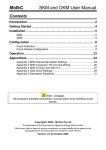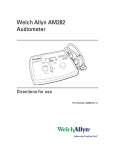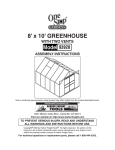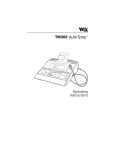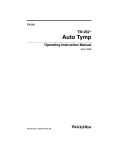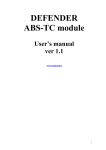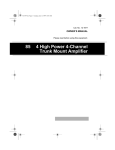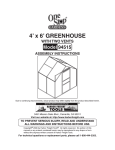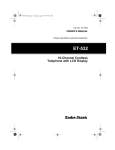Download Radio Shack Trunk Mount User's Manual
Transcript
12-1976.fm Page 1 Tuesday, July 13, 1999 10:01 AM Cat. No. 12-1976 OWNER’S MANUAL Please read before using this equipment. 4 × 25 Watt Trunk Mount Amplifier 4-Channel 100-Watt 12-1976.fm Page 2 Tuesday, July 13, 1999 10:01 AM FEATURES Your Optimus 4 × 25 Watt Trunk Mount Amplifier is designed to produce a total of 100 watts to give added punch and power to your vehicle’s existing stereo system. The amplifier produces up to 25 watts per channel of clean, powerful sound at all audio frequencies with minimum distortion. And, you can connect line-level as well as speaker outputs to the amplifier. Its features include: 14k Gold-Plated Noise-Isolated Line-Level Input Jacks - let you connect low-level (pre-amplifier) signal inputs to match your autosound system’s output for the best high-fidelity performance. Input Level Control - lets you adjust the level (high or low) of the audio signals that enter the amplifier. Automatic Power Switching - automatically turns on/off the amplifier when you turn on/off your autosound system. Short Circuit Protection - distorts sound if any output channel shorts to protect the amplifier from damage. Power Indicator - lights when power is on. Note: If the connectors from your autosound system are not compatible with the amplifier’s connectors, your local Radio Shack store sells adapter harnesses for many vehicles. 14k Gold-Plated Speaker Terminals - designed for low impedance, high conductivity, and minimum corrosion to provide the highest signal transfer and lowest sound distortion. © 1995 Tandy Corporation. All Rights Reserved. Optimus and Radio Shack are registered trademarks used by Tandy Corporation. 2 12-1976.fm Page 3 Tuesday, July 13, 1999 10:01 AM CONTENTS Preparation ..................................................................................................... 4 Choosing a Mounting Location .................................................................. 4 Before You Begin the Installation ............................................................... 4 Connecting Ground and Primary/Switched Power .................................... 5 Connecting Your Autosound System ......................................................... 7 Low Level Input Connections .............................................................. 7 High-level Input Connections ............................................................ 10 Connecting the Speakers ........................................................................ 13 Preparing the Speaker Wires ............................................................ 13 Connecting Four Speakers ................................................................ 14 Connecting Two Speakers ................................................................ 15 Testing the Connections .......................................................................... 16 Mounting the Amplifier ............................................................................. 16 Operation ...................................................................................................... 18 Turning On the Amplifier .......................................................................... 18 Setting the Level Control ......................................................................... 18 Maintenance .................................................................................................. Replacing the Fuses ................................................................................ Replacing the Tube-Type Fuse ......................................................... Replacing the Blade-Type Fuse ........................................................ 20 21 21 21 Specifications ............................................................................................... 22 3 12-1976.fm Page 4 Tuesday, July 13, 1999 10:01 AM PREPARATION CHOOSING A MOUNTING LOCATION The ideal location for mounting the amplifier is in your vehicle’s trunk. Wherever you decide to mount it, choose a mounting location that: • Does not interfere with the vehicle’s operation • Lets you drill mounting holes without damaging other vehicle components • Allows enough space around the cooling fins for proper airflow and cooling Warning: The amplifier gets very hot while it is on. Do not touch the amplifier or place flammable objects near it while it is on. BEFORE YOU BEGIN THE INSTALLATION Before you install your amplifier, carefully read all the instructions in this owner’s manual. You should be able to answer all of these questions about your vehicle’s electrical and sound systems. • Does my vehicle have a 12-volt negative ground system? (If it does not, you cannot use this amplifier.) • Which of the amplifier’s wires is the power wire? • How do I connect a wire to the fuse box? • Which amplifier terminals are line-level inputs, which are speaker-level inputs, and which are speaker outputs? Important! • Be aware that installation in your vehicle may require cutting or modifying your vehicle. • Do not cut any of the amplifier’s wires. If you cut any wire, you cannot obtain a refund or exchange on this product. Radio Shack will provide warranty service if you cut a wire and find the product is defective. 4 12-1976.fm Page 5 Tuesday, July 13, 1999 10:01 AM Cautions: • To prevent damage to your amplifier or autosound system, you must first connect the ground, primary, and switched power wires (as described in “Connecting Ground and Primary/Switched Power” before you connect the speakers to the amplifier. Make the connections only in the order shown. Damage to the amplifier is possible if you connect any wire incorrectly. • Turn on the power to test the connections before you permanently mount the amplifier (see “Testing the Power Connections”). • Be sure your speakers can handle 25 watts per channel if you connect the autosound system to two pairs of speakers (or 50 watts per channel if you connect the autosound system to only one pair of speakers). Each speaker must have an impedance of at least 4 ohms. Your local Radio Shack store carries a full line of speakers to choose from. CONNECTING GROUND AND PRIMARY/SWITCHED POWER 1. To prevent damage to your amplifier or autosound system while making the connections, disconnect the negative (-) cable from your vehicle’s battery. 5 12-1976.fm Page 6 Tuesday, July 13, 1999 10:01 AM Note: After you complete the connections and reconnect the battery wire, you will need to reset all clock/timer/memory devices in your vehicle. 2. Connect the supplied dark blue/white wire’s end to the amplifier’s REM (remote power) terminal. 3. Securely connect the supplied dark blue/white wire’s male quick disconnect plug to your autosound system’s switched power lead. This connection turns your amplifier on or off when you turn your autosound system on or off. Note: If your autosound system does not have a remote power output lead, connect this wire to a point in your vehicle’s ignition switch that provides 12volt battery power when the ignition is set to ON or ACC. This connection turns on the amplifier when you turn your ignition switch to on (or to ACC) and turns off the amplifier when you turn off the ignition. 4. Connect the black wire’s spade connector to the amplifier’s GND terminal. 5. Securely connect the black wire’s eyelet-terminal to a nearby metal ground, such as a bolt attached to a part of the vehicle’s chassis. Note: Be sure the bolt is not insulated from the chassis by a plastic part or other insulating material. 6. Connect the red wire’s spade connector to the amplifier’s +12V terminal. 7. Remove the nut from the battery’s positive ( +) terminal bolt, then place the red wire’s 10A fused eyelet terminal over the end of the bolt. Caution: Due to the amplifier’s high current requirement, you MUST connect the red wire’s fused end directly to the vehicle’s positive (+) battery cable terminal or damage to your vehicle’s wiring could result. Note: Do not reconnect your vehicle battery’s negative (-) cable yet. 6 12-1976.fm Page 7 Tuesday, July 13, 1999 10:01 AM CONNECTING YOUR AUTOSOUND SYSTEM Low Level Input Connections You can connect your autosound system’s low-level phono output jacks to the amplifier’s LOW INPUT phono jacks. Note: For a cleaner, less noisy signal transfer between your autosound system and the amplifier, the amplifier’s LOW INPUT phono jacks are gold-plated. For the best results, use shielded audio cables, such as Cat. No. 42-2368 (not supplied). If your autosound system has only two phono outputs, you will also need two shielded Y-adapter cables, such as Cat. No. 42-2435 (not supplied). 1. Temporarily place the amplifier as close as possible to the selected mounting location. 2. If your autosound system has four phono outputs and you are using four speakers, connect the autosound system to the amplifier using audio cables as follows: front-left to FRONT L, front-right to FRONT R, rear-left to REAR L, and rear-right to REAR R: 7 12-1976.fm Page 8 Tuesday, July 13, 1999 10:01 AM If your autosound system has four phono outputs but you are using only two speakers (front or rear) , connect only the corresponding autosound system’s output jacks to the amplifier using audio cables as follows: • front-left to FRONT L and front-right to FRONT R, or • rear-left to REAR L and rear-right to REAR R 8 12-1976.fm Page 9 Tuesday, July 13, 1999 10:01 AM If your autosound system has only two phono output jacks (left and right) and you are using four speakers, first connect the single phono plug end of a Y-adapter shielded audio cable to each autosound system output jack. Then: • Connect the other two ends of the left Y-adapter to the amplifier’s corresponding FRONT L and REAR L phono jacks • Connect the other two ends of the right Y-adapter to the amplifier’s corresponding FRONT R and REAR R phono jacks 9 12-1976.fm Page 10 Tuesday, July 13, 1999 10:01 AM If your autosound system has only two phono output jacks (left and right) and you are using only two speakers, simply connect them to the amplifier’s corresponding FRONT L and FRONT R, or REAR L and REAR R phono jacks. High-Level Input Connections If your stereo system has only speaker outputs, you can connect them to the amplifier’s rear HIGH INPUT and front HIGH INPUT sockets using the floating ground connection or the common ground connection method. 10 12-1976.fm Page 11 Tuesday, July 13, 1999 10:01 AM If your autosound system has four speaker outputs and you are going to use four speakers: Floating Ground Connection Common Ground Connection 11 12-1976.fm Page 12 Tuesday, July 13, 1999 10:01 AM If your autosound system has only two speaker outputs and you are going to use four speakers: Floating Ground Connection Common Ground Connection 12 12-1976.fm Page 13 Tuesday, July 13, 1999 10:01 AM CONNECTING THE SPEAKERS With the speakers placed in their approximate locations, run one speaker wire from each speaker to the amplifier. We recommend you use 16- or 18-gauge marked or color-coded wires to help you correctly connect the speakers to your amplifier. For the maximum bass response and the best overall performance, keep your speakers properly phased (connect + to + and - to -). Caution: Do not connect the speakers’ negative (-) terminal wires to chassis ground. Note: Speaker wires have two conductors. Color-coded wires have a stripe running down one of the conductors or different colored insulation for each conductor. Your local Radio Shack store has a wide selection of speaker wire to choose from. Preparing the Speaker Wires 1. Separate each speaker wire’s two conductors at both ends for a length of about 4 inches. 2. Strip the insulation from the ends of each conductor to expose 1/4 inch of wire. Note: Be sure to twist the ends to secure loose strands. 13 12-1976.fm Page 14 Tuesday, July 13, 1999 10:01 AM Connecting Four Speakers 1. Connect one end of a speaker wire’s marked conductor to the amplifier’s FL+ (front-left positive) terminal. 2. Connect one end of the speaker wire’s unmarked conductor to the amplifier’s FL- (front-left negative) terminal. 3. Repeat Steps 1 and 2 to connect a speaker wire to the amplifier’s FR (frontright) terminals. 4. Repeat Steps 1 - 3 to connect speaker wires to the amplifier’s RL (rear-left) and RR (rear-right) terminals. 5. Connect the other ends of the four speaker wires so FL connects to the front-left speaker, FR to the front-right speaker, RL to the rear-left speaker, and RR to the rear-right speaker. 14 12-1976.fm Page 15 Tuesday, July 13, 1999 10:01 AM Connecting Two Speakers If you are connecting only two speakers, you can connect them to the amplifier’s front (FL and FR) or rear (RL and RR) speaker terminals. 1. Connect one end of a speaker wire’s marked conductor to the amplifier’s FL+ (front-left positive) or RL + (rear-left positive) terminal. 2. Connect the end of the speaker wire’s unmarked conductor to the amplifier’s FL− (front-left negative) or RL − (rear-left negative) terminal. 3. Repeat Steps 1 and 2 to connect a speaker wire to the amplifier’s FR+ and FR− (front-right) or RR + or RR − (rear-right) terminals. 4. Connect the other ends of the speaker wires so FL connects to the front-left speaker and FR to the front-right speaker, or RL connects to the rear-left speaker and RR connects to the rear-right speaker. 15 12-1976.fm Page 16 Tuesday, July 13, 1999 10:01 AM TESTING THE CONNECTIONS Before you permanently mount the amplifier, temporarily reconnect your vehicle battery’s negative (-) cable, turn your vehicle’s ignition to ON or ACC, then test the connections. The amplifier is properly connected to the autosound system and speakers if you can verify that the amplifier and the autosound system turn on properly and the speakers’ sound is clear and unmuffled. If you cannot quickly verify that all components operate properly, immediately turn off your vehicle’s ignition. Then disconnect your vehicle battery’s negative ( -) cable and recheck your connections. If you verify that all components operate properly, mark the connections to insure easy identification of each wire, then follow the instructions under “Mounting the Amplifier.” MOUNTING THE AMPLIFIER Before you begin mounting the amplifier, make sure you have the following supplied hardware necessary for mounting. • 4 sheet-metal screws • 4 spring washers • 4 flat washers Then confirm that the amplifier fits your vehicle’s mounting area. Caution: Be careful to not drill into anything behind the mounting surface 1. Temporarily disconnect your vehicle battery’s negative ( -) cable again. 2. To make mounting more convenient, temporarily disconnect the amplifier’s wiring (ground, primary power, remote power, your autosound system’s input, and speakers). 16 12-1976.fm Page 17 Tuesday, July 13, 1999 10:01 AM 3. Using the mounting holes on the amplifier as a guide, mark the locations for the mounting holes. 4. Drill 9/64-inch holes in the marked locations, being careful not to damage anything behind the mounting surface. 5. Attach the amplifier to the mounting surface using the supplied sheet-metal screws and washers. 6. Reconnect the wiring. 7. Reconnect your vehicle battery’s negative (-) cable. 17 12-1976.fm Page 18 Tuesday, July 13, 1999 10:01 AM OPERATION TURNING ON THE AMPLIFIER The amplifier automatically turns on whenever you turn on your autosound system. POWER lights when the amplifier is operating. SETTING THE LEVEL CONTROL For the best performance, you can adjust the level of the audio signals that enter the amplifier by following these steps. Cautions: • The sound distorts if any output channel shorts. Turn off the amplifier and try to locate the short. • To prevent draining the vehicle’s battery, do not play the amplifier for too long using the ignition switch’s ACC position after turning off the vehicle’s ignition. 1. Using a flat blade screwdriver, turn both LEVEL MIN/MAX controls fully counterclockwise to MIN. Note: The right level control is for the front speakers; the left level control is for the rear speakers. 18 12-1976.fm Page 19 Tuesday, July 13, 1999 10:01 AM 2. Temporarily turn up the autosound system’s volume control to about onethird of its full range. Caution: Never turn the level controls up any farther than you need to get clear sound at two thirds volume maximum. 3. Turn either the left or right LEVEL control clockwise until you can hear the sound at a comfortable level. 4. Turn up the volume on your autosound system until the sound begins to distort. Then immediately turn down the volume to the point just below where distortion began. 5. Adjust the level controls until the volume is at the maximum level you want the autosound system to produce. 6. Adjust the autosound system’s volume control to a comfortable listening level. 19 12-1976.fm Page 20 Tuesday, July 13, 1999 10:01 AM MAINTENANCE Your Optimus 4 × 25 Watt Trunk Mount Amplifier is an example of superior design and craftsmanship. The following suggestions will help you care for your amplifier so you can enjoy it for years. Keep the amplifier dry. If it gets wet, wipe it dry immediately. Liquids can contain minerals that corrode electronic circuits. Use and store the amplifier only in normal temperature environments. Temperature extremes can shorten the life of electronic devices and distort or melt plastic parts. Handle the amplifier gently and carefully. Dropping it can damage circuit boards and cases and cause the amplifier to work improperly. Keep the amplifier away from dust and dirt, which can cause premature wear of parts. CLEANER Wipe the amplifier with a damp cloth occasionally to keep it looking new. Do not use harsh chemicals, cleaning solvents, or strong detergents to clean the amplifier. Modifying or tampering with the amplifier’s internal components can cause a malfunction and invalidate your amplifier’s warranty. If your amplifier is not performing as it should, take it to your local Radio Shack store for assistance. 20 12-1976.fm Page 21 Tuesday, July 13, 1999 10:01 AM REPLACING THE FUSES If the amplifier shuts down, you might need to replace the power wire’s 10-amp tube-type fuse (such as Cat. No. 270-1072, not supplied), the 10-amp blade-type fuse (such as Cat. No. 270-1081, not supplied) on the back panel, or both fuses. Cautions: • Do not use fuses with ratings other than those specified here. Doing so might damage your amplifier. • After replacing a fuse, let the amplifier cool down before you turn it on again. Turn off your autosound system, then disconnect your vehicle battery’s negative (-) terminal. Replacing the Tube-Type Fuse 1. Grasp the two ends of the power wire’s fuse holder and twist them counterclockwise, then pull the ends apart. 2. Insert a new 10-amp, tube-type fuse into the longer of the two fuse-holder’s ends, then grasp the fuse-holder’s two ends, push them in and twist them clockwise to secure them. Replacing the Blade-Type Fuse 1. Grasp the fuse’s plastic end and pull it out. 2. Grasp the new fuse’s plastic end and simply push it in. 21 12-1976.fm Page 22 Tuesday, July 13, 1999 10:01 AM SPECIFICATIONS Output Power @ 14.4 VDC 1 kHz 10% THD Front .................................................................................................25W Rear ..................................................................................................25W ¥2 ¥2 Frequency Response ........................................................ 20–20,000 Hz (±3 dB) Input Impedance Low Input ....................................................................................... 10 kOhms High Input ......................................................................................100 Ohms Input Sensitivity (for 10% THD Output Power) Low Input ........................................................................................... 150 mV High Input .............................................................................................. 2.5 V Power Supply Voltage ............................DC 14.4V Negative Ground (10.5–16V) Maximum Current Draw ................................................................................. 10A Matching Speaker Impedance ............................................... 4 Ohms or Greater Fuse Requirement ........................................................................................ 10 A Dimensions ..........................................................21/4 ¥ 71/4 ¥ 81/4 Inches (HWD) ..................................................................................... (53 ¥ 200 ¥ 210 mm) Net Weight ....................................................................................3.7 lbs (1.7 kg) Specifications are typical; individual units might vary. Specifications are subject to change and improvement without notice. 22 12-1976.fm Page 23 Tuesday, July 13, 1999 10:01 AM NOTES 23 12-1976.fm Page 24 Tuesday, July 13, 1999 10:01 AM RADIO SHACK LIMITED WARRANTY This product is warranted against defects for 1 year from date of purchase from Radio Shack company-owned stores and authorized Radio Shack franchisees and dealers. Within this period, we will repair it without charge for parts and labor. Simply bring your Radio Shack sales slip as proof of purchase date to any Radio Shack store. Warranty does not cover transportation costs. Nor does it cover a product subjected to misuse, accidental damage, alteration or improper installation. EXCEPT AS PROVIDED HEREIN, RADIO SHACK MAKES NO EXPRESS WARRANTIES AND ANY IMPLIED WARRANTIES ARE LIMITED IN DURATION TO THE DURATION OF THE WRITTEN LIMITED WARRANTIES CONTAINED HEREIN. Some states do not permit limitation or exclusion of implied warranties; therefore, the aforesaid limitation(s) or exclusion(s) may not apply to the purchaser. This warranty gives you specific legal rights and you may also have other rights which vary from state to state. We Service What We Sell 9/94 RADIO SHACK A Division of Tandy Corporation Fort Worth, Texas 76102 7A5 Printed in Taiwan

























